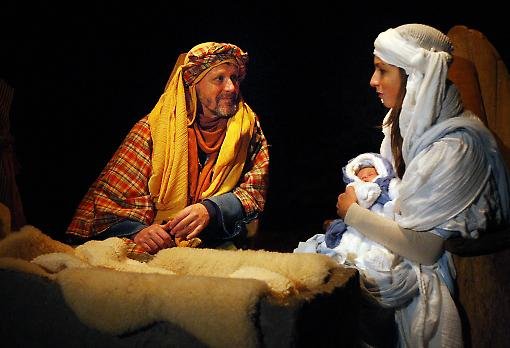Colm Tóibín's Mary: helps us understand the inexplicable

Mary and Joseph hold the baby Jesus in a performance of the nativity story.
Photograph: Getty Images
Colm Tóibín’s debut novel, The South (1990), was one of the first books I reviewed for a national newspaper. Set in Ireland and Spain in the 1930s, it is one of his finest works of fiction. The prose is spare and has a kind of stillness in it. He has since written about emigration to America in the 1950s, Argentina at the time of the junta, Henry James and sexuality. I have taken all these subjects in my stride. Now he has written about Mary, the mother of Jesus, with whose story I am, frankly, unfamiliar in all but the broadest detail.
Is this a disadvantage? Can we come at history or mythology cold? Thomas Cromwell was a minor A-level history topic until, in Hilary Mantel’s hands, he was turned into a literary superhero. But perhaps Mary is too well known? After all, her life is recorded in one of the two great originating books of the Judaeo- Christian tradition. The question for the wary reader approaching Tóibín’s novel is whether it is an atheist’s demolition job or an attempt to deepen our religious understanding of the birth, the death and the resurrection. Or is it something else still – a personal study of grief and the attempt by a mother to understand the events that have led to the brutal death of her now-celebrated son?
Mary is a bereaved widow, lonely and old. Joseph’s chair remains, but no one is allowed to sit in it. After the crucifixion, she is hunted by the authorities and is now under the protection of her son’s friends. Their role is to ensure that the story told of the crucifixion is the correct, emerging Christian one.
Mary is a doubter; she has seen Jesus preaching, “his voice all false and his tone all stilted”. Only when they are alone together does he seem “cleansed of whatever had been agitating him”. She sees the miracles performed by her son as a “crowd roaming the countryside like a swarm of locusts in need of want and affliction”. Tóibín describes the raising of Lazarus as a kind of zombie possession. If Lazarus was indeed alive again, then he had seen something that had “frightened him beyond belief”. Tóibín is preoccupied by silences and their enemies: the silence of death, the clamour of the preaching. “Death needs time and silence,” he writes. One senses Mary putting her hands around her ears to protect herself from the din and commotion of Roman Palestine and her son’s acolytes. She needs solitude in order to be able to think and feel and remember.
Tóibín depicts a row between Mary and Jesus in which she has to remind him angrily that she is his mother. He annoys her with his “high-flown talk and riddles” and frightens her by pronouncing himself the Son of God. Many mothers of children with mental illness might view their offspring as Mary does, remembering waking him in the morning and how his childhood was filled with happiness. The sheer masculinity of the grown man, and his pride, repel her.
Mary feels she is witnessing a mob hysteria growing up around her son. Soon she learns he is to be crucified and the novel proceeds with the horrifying detail of the execution. In a terrific description of the mob, Mary observes: “There was a dark vacancy in the faces of some, and they wanted this vacancy filled with cruelty, pain and with the sound of someone crying out.” The burial and Jesus’s rising on the third day seem to her to be a collective dream, not a real event. Myths are already growing up around him, and her own testimony is not believed. Perhaps she is not being so much protected by the friends of Jesus as guarded, to prevent her story from leaking out.
The final sentence in the book refers to “the gods of this place”. I don’t think she means the Holy Trinity but an older, more comforting paganism. Facing her own death, she moves towards silence and the “soothing, dwindling light”. There is something archetypal about her; she appears here not as a modern woman, but as a way for Tóibín to understand the infinite and the inexplicable. This is a flawless work, touching, moving and terrifying – even for an atheist Jew like me.
Linda Grant’s most recent novel is “We Had It So Good” (Virago, £7.99).


 Votes : 0
Votes : 0









